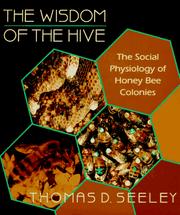| Listing 1 - 10 of 25 | << page >> |
Sort by
|
Book
ISBN: 0190872306 0190872292 9780190872298 9780190872281 0190872284 Year: 2018 Publisher: New York, NY, United States of America
Abstract | Keywords | Export | Availability | Bookmark
 Loading...
Loading...Choose an application
- Reference Manager
- EndNote
- RefWorks (Direct export to RefWorks)
Honeybee --- Life cycles.
Book
ISBN: 9781613249031 1613249039 9781613248256 1613248253 Year: 2012 Publisher: New York
Abstract | Keywords | Export | Availability | Bookmark
 Loading...
Loading...Choose an application
- Reference Manager
- EndNote
- RefWorks (Direct export to RefWorks)
Honeybee. --- Honeybee --- Apis mellifera --- European honeybee --- Hive bee --- Honey bee --- Apis (Insects) --- Bees --- Bee culture --- Diseases.

ISBN: 0674043405 9780674043404 9780674953765 0674953762 0140263098 9780140263091 Year: 2022 Publisher: Cambridge, MA
Abstract | Keywords | Export | Availability | Bookmark
 Loading...
Loading...Choose an application
- Reference Manager
- EndNote
- RefWorks (Direct export to RefWorks)
This book describes and illustrates the results of more than fifteen years of elegant experimental studies conducted by the author to investigate how a colony of bees is organized to gather its resources. The results of his research--including studies of the shaking signal, tremble dance, and waggle dance--offer the clearest, most detailed picture available of how a highly integrated animal society works.
Honeybee --- Apis mellifera --- European honeybee --- Hive bee --- Honey bee --- Apis (Insects) --- Bees --- Bee culture --- Food. --- Behavior.
Book
ISBN: 1501717928 9781501717925 0801493021 9780801493027 0801404002 9780801404009 Year: 2018 Publisher: Ithaca, NY
Abstract | Keywords | Export | Availability | Bookmark
 Loading...
Loading...Choose an application
- Reference Manager
- EndNote
- RefWorks (Direct export to RefWorks)
First published in 1956, this classic work on the anatomy of honey bee by R. (Robert) E. Snodgrass is acclaimed as much for the author's remarkably detailed line drawings of the various body parts and organs of his subject as for his authoritative knowledge of entomology and the engaging prose style with which he conveys it. This book should be in the library of every student of the honey bee and bee behavior-beekeepers (both amateur and professional) as well as scientists.
Insects --- Honeybee --- Apis mellifera --- European honeybee --- Hive bee --- Honey bee --- Apis (Insects) --- Bees --- Bee culture --- Anatomy.
Book
ISBN: 9781400857876 1400857872 0691611343 0691639353 Year: 2014 Publisher: Princeton, NJ
Abstract | Keywords | Export | Availability | Bookmark
 Loading...
Loading...Choose an application
- Reference Manager
- EndNote
- RefWorks (Direct export to RefWorks)
The book presents honeybees as a model system for investigating advanced social life among insects from an evolutionary perspective.Originally published in 1985.The Princeton Legacy Library uses the latest print-on-demand technology to again make available previously out-of-print books from the distinguished backlist of Princeton University Press. These editions preserve the original texts of these important books while presenting them in durable paperback and hardcover editions. The goal of the Princeton Legacy Library is to vastly increase access to the rich scholarly heritage found in the thousands of books published by Princeton University Press since its founding in 1905.
Insects --- Honeybee --- Apis mellifera --- European honeybee --- Hive bee --- Honey bee --- Apis (Insects) --- Bees --- Bee culture --- Ecology.

ISBN: 1501711563 9781501711565 0801434777 9780801434778 0801484782 9780801484780 Year: 2018 Publisher: Ithaca, NY
Abstract | Keywords | Export | Availability | Bookmark
 Loading...
Loading...Choose an application
- Reference Manager
- EndNote
- RefWorks (Direct export to RefWorks)
A scientist before he was a beekeeper, Mark L. Winston found in his new hobby a paradigm for understanding the role science should play in society. In essays originally appearing as columns in Bee Culture, the leading professional journal, Winston uses beekeeping as a starting point to discuss broader issues, such as how agriculture functions under increasingly complex social and environmental restraints, how scientists grapple with issues of accountability, and how people struggle to maintain contact with the natural world. Winston's reflections on bees, beekeeping, and science cover a period of tumultuous change in North America, a time when new parasites, reduced research funding, and changing economic conditions have disrupted the livelihoods of bee farmers."Managed honeybees in the city provide a major public service by pollinating gardens, fruit trees, and berry bushes, and should be encouraged rather than legislated out of existence. Our cities, groomed and cosmopolitan as they appear, still obey the basic rules of nature, and our gardens and yards are no exception. Homegrown squashes, apple trees, raspberries, peas, beans, and other garden crops require bees to move the pollen from one flower to another, no matter how urbanized or sophisticated the neighborhood."
Bee culture. --- Honeybee. --- Apis mellifera --- European honeybee --- Hive bee --- Honey bee --- Apis (Insects) --- Bees --- Bee culture --- Apiculture --- Bee keeping --- Beekeeping --- Honeybee --- Honeybee culture --- Keeping, Bee --- Keeping bees --- Rearing of bees --- Insect rearing --- Rearing
Book
ISBN: 9780674041622 0674041623 Year: 2009 Publisher: Cambridge, MA
Abstract | Keywords | Export | Availability | Bookmark
 Loading...
Loading...Choose an application
- Reference Manager
- EndNote
- RefWorks (Direct export to RefWorks)
The familiar European hive bee, Apis mellifera, has long dominated honey bee research. But in the last 15 years, teams in China, Japan, Malaysia, and Thailand began to shift focus to the indigenous Asian honey bees. Benjamin Oldroyd, well known for his work on the genetics and evolution of worker sterility, has teamed with Siriwat Wongsiri, a pioneer of the study of bees in Thailand, to provide a comparative work synthesizing the rapidly expanding Asian honey bee literature. After introducing the species, the authors review evolution and speciation, division of labor, communication, and nest defense. They underscore the pressures colonies face from pathogens, parasites, and predators--including man--and detail the long and amazing history of the honey hunt. This book provides a cornerstone for future investigations on these species, insights into the evolution across species, and a direction for conservation efforts to protect these keystone species of Asia's tropical forests.
Honeybee --- NATURE / Animals / Insects & Spiders. --- Apis mellifera --- European honeybee --- Hive bee --- Honey bee --- Apis (Insects) --- Bees --- Bee culture --- Behavior --- Conservation
Book
ISBN: 9780691160771 0691160775 1400874157 1786849534 9781400874156 9781786849533 Year: 2015 Publisher: Princeton, NJ
Abstract | Keywords | Export | Availability | Bookmark
 Loading...
Loading...Choose an application
- Reference Manager
- EndNote
- RefWorks (Direct export to RefWorks)
The Bees in Your Backyard provides an engaging introduction to the roughly 4,000 different bee species found in the United States and Canada, dispelling common myths about bees while offering essential tips for telling them apart in the field.The book features more than 900 stunning color photos of the bees living all around us-in our gardens and parks, along nature trails, and in the wild spaces between. It describes their natural history, including where they live, how they gather food, their role as pollinators, and even how to attract them to your own backyard. Ideal for amateur naturalists and experts alike, it gives detailed accounts of every bee family and genus in North America, describing key identification features, distributions, diets, nesting habits, and more.Provides the most comprehensive and accessible guide to all bees in the United States and CanadaFeatures more than 900 full-color photosOffers helpful identification tips and pointers for studying beesIncludes a full chapter on how to attract bees to your backyard
Bee culture. --- Bees. --- Bumblebees. --- Honeybee. --- Bees --- Bee culture --- Honeybee --- Bumblebees --- Abeilles --- Apiculture --- Abeille --- Bourdons --- Identification --- North America. --- Bombinae --- Bombini --- Bombus --- Bumble bees --- Humble-bees --- Humblebees --- Apis mellifera --- European honeybee --- Hive bee --- Honey bee --- Bee keeping --- Beekeeping --- Honeybee culture --- Keeping, Bee --- Keeping bees --- Rearing of bees --- Aculeata --- Apoidea --- Bee --- Rearing --- Apidae --- Apis (Insects) --- Insect rearing --- Hymenoptera --- Insect societies --- Nectarivores --- Bugonia --- Identification.
Book
ISBN: 9780674073029 0674073029 0674075544 0674075560 9780674075542 9780674075566 Year: 2013 Publisher: Cambridge, Massachusetts Harvard University Press
Abstract | Keywords | Export | Availability | Bookmark
 Loading...
Loading...Choose an application
- Reference Manager
- EndNote
- RefWorks (Direct export to RefWorks)
Charles Darwin struggled to explain how forty thousand bees working in the dark, seemingly by instinct alone, could organize themselves to construct something as perfect as a honey comb. How do bees accomplish such incredible tasks? Synthesizing the findings of decades of experiments, The Spirit of the Hive presents a comprehensive picture of the genetic and physiological mechanisms underlying the division of labor in honey bee colonies and explains how bees' complex social behavior has evolved over millions of years. Robert Page, one of the foremost honey bee geneticists in the world, sheds light on how the coordinated activity of hives arises naturally when worker bees respond to stimuli in their environment. The actions they take in turn alter the environment and so change the stimuli for their nestmates. For example, a bee detecting ample stores of pollen in the hive is inhibited from foraging for more, whereas detecting the presence of hungry young larvae will stimulate pollen gathering. Division of labor, Page shows, is an inevitable product of group living, because individual bees vary genetically and physiologically in their sensitivities to stimuli and have different probabilities of encountering and responding to them. A fascinating window into self-organizing regulatory networks of honey bees, The Spirit of the Hive applies genomics, evolution, and behavior to elucidate the details of social structure and advance our understanding of complex adaptive systems in nature.
Beehives. --- Honeybee --- Pollen. --- Behavior. --- Evolution. --- Beehives --- Pollen --- Evolution --- Behavior --- Honeybee -- Behavior. --- Honeybee -- Evolution. --- Grains, Pollen --- Pollen grains --- Apis mellifera --- European honeybee --- Hive bee --- Honey bee --- Bee hives --- Bee houses --- Hives, Bee --- Pollinaria --- Anther --- Palynology --- Pollination --- Apis (Insects) --- Bees --- Bee culture --- Apiaries --- Housing --- Equipment and supplies
Book
ISBN: 1613243731 9781613243732 1606926888 9781606926888 Year: 2009 Publisher: New York Nova Science Publishers
Abstract | Keywords | Export | Availability | Bookmark
 Loading...
Loading...Choose an application
- Reference Manager
- EndNote
- RefWorks (Direct export to RefWorks)
Bee culture --- Colony collapse disorder of honeybees --- Honeybee --- Insect pollinators --- Pollination by insects --- Health aspects --- Diseases
| Listing 1 - 10 of 25 | << page >> |
Sort by
|

 Search
Search Feedback
Feedback About UniCat
About UniCat  Help
Help News
News